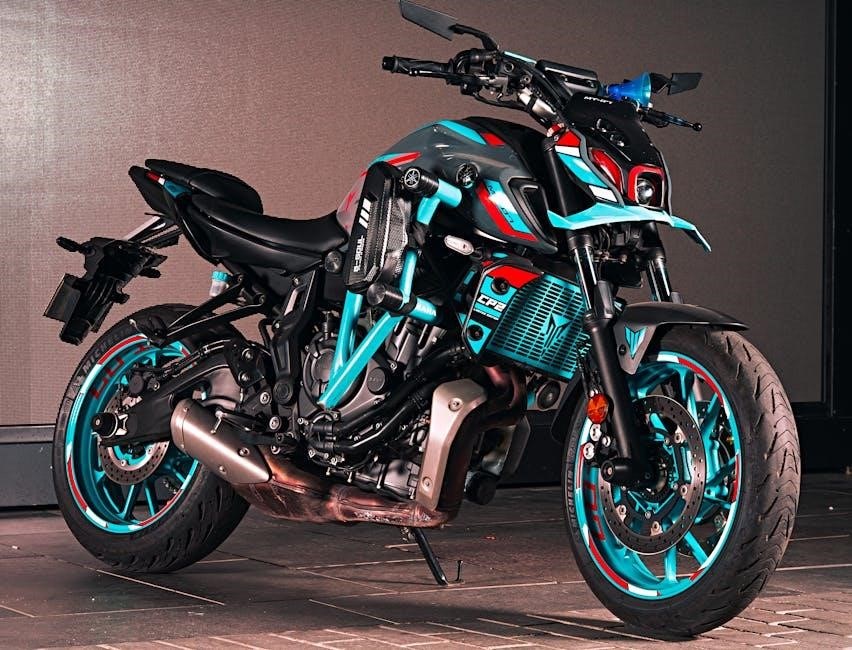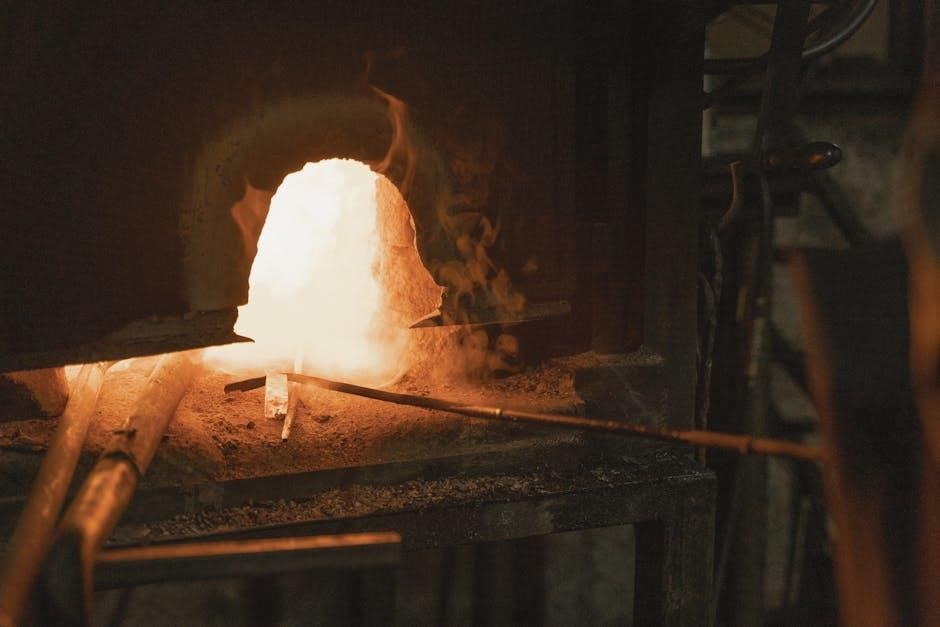
power brakes vs manual
Power brakes use a booster to amplify braking force, reducing effort and improving stopping efficiency, while manual brakes rely solely on driver input for operation.
Overview of Brake Systems
Brake systems are essential for vehicle safety, with power brakes using a booster to amplify braking force, while manual brakes rely on direct driver input. Power brakes typically utilize vacuum pressure from the engine or a dedicated pump to assist in applying brake force, reducing pedal effort. Manual brakes, however, depend solely on the driver’s strength and mechanical advantage, often requiring more force. Both systems aim to provide reliable stopping power, but their mechanisms and efficiency levels differ significantly, impacting overall vehicle control and safety.
Importance of Choosing the Right Brake System
Selecting the appropriate brake system is crucial for safety, performance, and driver comfort. Power brakes offer enhanced stopping power with less effort, making them ideal for modern vehicles and heavy-duty applications. Manual brakes, while simpler and cost-effective, require more driver input and are often preferred in racing or classic cars. The choice between the two significantly impacts braking efficiency, vehicle control, and overall driving experience, ensuring optimal safety and reliability under various conditions.

Understanding Power Brakes
Power brakes use a booster, often vacuum-assisted, to amplify braking force, enabling quicker stops with less pedal effort compared to manual systems.
Definition and Functionality
Power brakes utilize a booster, often vacuum-assisted, to amplify braking force, enabling quicker stops with less pedal effort. Manual brakes rely solely on driver input, requiring physical strength to apply pressure, making them more demanding in heavy traffic or frequent stopping scenarios.
Components of a Power Brake System
A power brake system includes a booster, master cylinder, and vacuum or hydraulic assist. The booster amplifies pedal force, while the master cylinder converts non-hydraulic pressure into hydraulic pressure. Dual reservoir master cylinders ensure safety by separating brake circuits, preventing total brake failure if one circuit fails. These components work together to provide enhanced braking efficiency and reduced driver effort compared to manual systems.
How Power Brakes Enhance Braking Performance
Power brakes significantly enhance braking performance by amplifying the force applied to the brake pedals, enabling quicker and more efficient stops. The booster assists in applying pressure, reducing driver effort and fatigue. This results in faster response times and improved control, especially in emergency situations. Additionally, power brakes maintain consistent braking performance across varying driving conditions, making them ideal for modern vehicles and heavy-duty applications where reliability and safety are paramount;

Understanding Manual Brakes
Manual brakes rely on direct driver input without assistance from a booster, requiring physical effort to apply pressure and engage the braking system effectively.
Definition and Mechanism
Manual brakes operate without power assistance, relying solely on the driver’s physical effort to apply pressure through the brake pedal. This pressure is transferred mechanically to the master cylinder, which then activates the brake calipers or wheel cylinders to engage the brakes. Unlike power brakes, manual systems lack a booster, requiring more force from the driver but offering precise control and modulation, especially in scenarios where fine-tuned braking is essential.
Components of a Manual Brake System
A manual brake system consists of a brake pedal, master cylinder, brake lines, and calipers or wheel cylinders. The pedal connects to the master cylinder, which converts non-assisted pedal pressure into hydraulic force. Brake lines transmit this pressure to the calipers or wheel cylinders, engaging the brake pads or shoes to stop the vehicle. This straightforward, mechanical setup eliminates the need for a power booster, offering simplicity and reliability in operation.
Advantages of Manual Brakes
Manual brakes offer precision control and direct driver feedback, making them ideal for racing and performance driving. They are lighter and simpler in design, reducing vehicle weight and complexity. With fewer components, manual brakes are more reliable and less prone to failure. They also eliminate the need for a power source, making them cost-effective and easier to maintain. This simplicity appeals to enthusiasts seeking a more connected driving experience and vehicles where weight reduction is critical.

Power Brakes vs Manual Brakes: A Direct Comparison
Power brakes enhance braking performance with reduced effort, while manual brakes rely on driver strength and offer direct control. Each system suits different driving needs and preferences.
Braking Performance and Efficiency
Power brakes deliver superior stopping power with minimal effort, leveraging a booster to amplify force. Manual brakes rely on driver input, offering precise modulation but requiring more strength. Power brakes excel in heavy-duty applications and long drives, reducing fatigue, while manual systems provide direct feedback, favored in racing for control and responsiveness. Each system balances efficiency and driver engagement, catering to specific needs and preferences.
Driver Effort and Comfort
Power brakes significantly reduce driver effort by using a booster to amplify pedal force, making braking easier and less tiring, especially in heavy vehicles or long drives. Manual brakes require more physical input, demanding greater leg strength and pedal pressure, which can lead to fatigue. However, manual systems often provide better pedal feel and direct control, appealing to drivers who prioritize precision over comfort. The choice between the two depends on whether ease of use or tactile feedback is more important.
Cost and Maintenance
Power brake systems generally have higher upfront costs due to the additional components like the booster and vacuum pump. Maintenance is also more complex, requiring regular checks of the booster and vacuum system. Manual brakes, while simpler and cheaper to install, may need more frequent pad replacements due to increased wear from constant driver effort. Overall, manual systems are more DIY-friendly, offering cost savings in the long run for drivers willing to handle the extra workload.
Reliability and Safety Features
Power brakes often include fail-safe mechanisms, such as dual reservoir master cylinders, to ensure braking even if one system fails. Manual brakes, while simpler, rely entirely on mechanical components and driver input, posing higher risks in emergency scenarios. Power brakes generally offer greater safety through redundancy and reduced driver error, making them preferable for modern vehicles. Manual systems, however, can be more reliable in situations where auxiliary power systems fail, provided proper maintenance is upheld.

Key Differences in Performance
Power brakes deliver superior stopping power and responsiveness due to booster assistance, while manual brakes rely on driver strength, offering less efficiency but greater control in specific scenarios.
Stopping Power and Responsiveness
Power brakes excel in delivering rapid and consistent stopping power, leveraging booster assistance to apply force efficiently. Manual brakes, while less powerful, offer precise modulation, ideal for drivers seeking direct control and feedback in specific driving conditions.
Pedal Feel and Modulation
Power brakes provide a softer pedal feel, reducing driver effort, while manual brakes offer a firmer, more tactile response, allowing precise modulation. This makes manual brakes preferred in racing for control, though less comfortable for everyday use.
System Complexity and Dependability
Power brakes are more complex, relying on boosters and vacuum systems, which can fail, while manual brakes are simpler and dependable, with fewer components to malfunction.

When to Choose Power Brakes
Power brakes are ideal for modern vehicles, heavy-duty applications, and long-distance driving, offering reduced driver effort and improved braking efficiency in demanding conditions.
Modern Vehicles and Heavy-Duty Applications
Modern vehicles and heavy-duty applications benefit significantly from power brakes due to their ability to provide consistent and reliable stopping power. The booster in power brake systems amplifies the force applied to the master cylinder, enabling quicker and more efficient braking, especially in larger or heavier vehicles. This reduces driver fatigue and enhances safety in demanding conditions. Additionally, power brakes are essential for meeting the braking demands of advanced safety features and modern traffic scenarios.
Long-Distance Driving and Traffic Conditions
Power brakes are ideal for long-distance driving and heavy traffic due to their reduced driver effort and consistent braking performance. They minimize fatigue during extended journeys and provide reliable stopping power in stop-and-go conditions. Manual brakes, while offering precise control, require constant effort, making them less practical for prolonged driving or congested urban scenarios where frequent braking is necessary. Power brakes enhance comfort and safety in these situations, making them the preferred choice for everyday commuting and highway driving.
Vehicles with Advanced Safety Features
Modern vehicles equipped with advanced safety features, such as ABS, stability control, and autonomous driving systems, benefit significantly from power brakes. These systems rely on precise and rapid actuation, which power brakes provide effortlessly. Manual brakes, while offering direct control, may not integrate seamlessly with these technologies, potentially limiting their effectiveness. Power brakes ensure optimal performance and safety in vehicles designed with cutting-edge driver-assistance features, making them the logical choice for such applications.
When to Choose Manual Brakes
Manual brakes are ideal for racing, classic cars, or situations requiring precise control, offering better modulation and driver feedback without the lag of power-assisted systems.
Classic Cars and Restoration Projects
Manual brakes are often preferred for classic cars and restoration projects to maintain authenticity and simplicity. They align with the original design, offering a more direct driving experience. Installation is typically straightforward, with bolt-in master cylinders available for easy conversion. However, safety is crucial, so upgrading to a dual reservoir master cylinder is recommended to ensure reliability. Manual brakes also avoid the complexity of power boosters, making them ideal for enthusiasts seeking a nostalgic feel without modern assists.
Racing and High-Performance Vehicles
Manual brakes are often favored in racing and high-performance vehicles for their precision and driver feedback. They provide better modulation, allowing drivers to fine-tune braking force, which is critical for competitive driving. Unlike power brakes, manual systems eliminate lag, offering a direct connection between the pedal and brakes. This responsiveness is vital for track performance. Additionally, manual brakes are lighter, reducing overall vehicle weight and enhancing power-to-weight ratios, making them a preferred choice for enthusiasts seeking optimal control and efficiency.
Off-Road and Specialized Applications
Manual brakes are often preferred in off-road and specialized applications due to their simplicity and reliability. They eliminate the dependency on power systems, which can fail in harsh environments. Manual brakes provide better modulation and driver feedback, essential for precise control in challenging terrains. Their lighter weight also enhances vehicle agility, making them ideal for custom or specialized vehicles where reliability and simplicity are paramount. This makes manual brakes a practical choice for off-road enthusiasts and unique applications.

Safety Considerations
Power brakes offer enhanced safety with fail-safe mechanisms, while manual brakes rely on driver skill and input, posing higher risks in emergency scenarios without assistance.
Fail-Safe Mechanisms in Power Brakes
Power brakes incorporate fail-safe mechanisms, such as dual reservoir master cylinders, ensuring continued braking functionality even if one system fails. This redundancy enhances safety, especially in emergencies, by maintaining control and preventing complete brake failure. Additionally, power brakes often include features like emergency boosters that provide assistance during critical stopping situations, further reducing the risk of accidents and improving overall vehicle reliability.
Risk Factors with Manual Brakes
Manual brakes pose risks due to increased pedal effort, requiring more driver strength and focus, which can lead to fatigue and delayed reactions. Without power assistance, stopping distances may increase, especially in emergencies. Additionally, manual systems lack redundancy, so any component failure can result in total brake loss, heightening accident risks. This makes them less reliable in high-stress or heavy-duty driving conditions compared to power brakes.
Emergency Braking Scenarios
In emergency situations, power brakes excel by providing faster and more efficient stopping power, reducing the risk of accidents. They apply maximum braking force instantly, minimizing stopping distances. Manual brakes, however, rely on the driver’s physical strength and reaction time, which can lead to delayed or incomplete braking in panic situations. This makes power brakes inherently safer in critical moments, while manual systems depend heavily on driver skill and composure.

Manual Brakes in Racing and Performance Driving
Manual brakes offer precision control and direct driver feedback, making them ideal for racing. They eliminate power assist lag, allowing for more linear and predictable braking performance.
Precision Control and Driver Feedback
Manual brakes provide direct pedal feedback, allowing drivers to precisely modulate braking force. This tactile connection enhances control, especially in high-performance scenarios where exact pressure adjustment is crucial. Unlike power-assisted systems, manual brakes eliminate lag, offering immediate response. This direct link between the driver’s input and the braking action is highly valued in racing, where split-second decisions and nuanced control can significantly impact performance and safety.
Weight Reduction and Simplified Systems
Manual brakes offer significant weight reduction by eliminating the power booster and vacuum pump, making them ideal for racing and performance vehicles. Simplified systems reduce complexity and potential failure points, enhancing reliability. This lightweight design improves power-to-weight ratios and handling, while also allowing for easier maintenance and customization. For instance, Wilwood Engineering’s Superlite brake kit exemplifies how manual systems can enhance braking capacity while maintaining a minimalist approach, benefiting high-performance applications where every ounce counts.
Driver Skill and Preference
Driver skill and preference play a crucial role in choosing between power and manual brakes. Manual brakes require more pedal effort and technique, appealing to experienced drivers who value precise control and feedback. Power brakes, however, are more forgiving and easier to operate, making them suitable for drivers who prioritize comfort and convenience. Ultimately, the choice depends on the driver’s ability to handle the demands of each system and their personal preference for braking feel and responsiveness.

Evolution of Brake Systems
Brake systems have evolved from manual to power-assisted, integrating advanced technologies for improved safety and efficiency, with future trends focusing on autonomous and regenerative braking solutions.
Historical Development of Power Brakes
The development of power brakes began in the mid-20th century, with vacuum-assisted systems becoming standard. These systems reduced driver effort by using engine vacuum to amplify braking force. Over time, advancements like electronic brakeforce distribution and dual reservoir master cylinders enhanced safety and reliability. Modern power brakes now integrate with advanced driver-assistance systems, offering unparalleled performance and efficiency compared to traditional manual systems.
Modern Advances in Manual Brake Technology
Manual brakes have evolved with lightweight materials and optimized designs, improving heat dissipation and pedal feel. High-performance calipers and master cylinders now offer precise control, making manual systems preferred in racing; Wilwood Engineering’s Superlite kits exemplify these advancements, combining durability with reduced weight. These innovations ensure manual brakes remain competitive, offering drivers superior modulation and feedback, especially in specialized applications where simplicity and responsiveness are crucial.
Future Trends in Braking Systems
Future braking systems will integrate advanced technologies like regenerative braking in electric vehicles and autonomous driving features. Power brakes will likely incorporate smarter boosters and adaptive systems for enhanced safety. Manual brakes may see niche applications in racing, while power systems dominate everyday vehicles. Both will focus on weight reduction, improved heat management, and seamless integration with driver-assistance technologies, ensuring optimal performance and safety across all driving scenarios.

Cost and Maintenance
Power brakes require higher initial investment and regular maintenance of boosters and fluid systems, while manual brakes are cost-effective with simpler, DIY-friendly upkeep needs.
Initial Investment and Long-Term Expenses
Power brakes require a higher initial investment due to components like boosters and dual reservoir master cylinders. Manual brakes are more cost-effective upfront but may demand more effort over time. Maintenance for power brakes involves checking boosters and fluid systems, while manual brakes simplify upkeep with fewer components. Long-term, manual systems often remain more budget-friendly, though power brakes offer enhanced performance, balancing higher costs with improved efficiency and safety features.
Service Requirements for Power Brakes
Power brakes require regular maintenance, including checking the booster, vacuum pump, and fluid levels. The dual reservoir master cylinder must be serviced to ensure proper function. Over time, the booster may need replacement, and the system should be inspected for leaks or wear. Proper upkeep ensures consistent braking performance and safety, making it essential to follow a routine service schedule to maintain reliability and efficiency in power brake systems.
DIY Friendliness of Manual Brakes
Manual brakes are more DIY-friendly due to their simpler design, requiring less specialized tools and knowledge. Enthusiasts can easily inspect and replace components like master cylinders and brake lines. The absence of complex systems like vacuum boosters or electronic controls makes manual brakes more accessible for home mechanics. This simplicity reduces reliance on professional services, allowing car owners to maintain and upgrade their braking systems independently, which is particularly appealing for classic car restorations and racing applications.
Choosing between power and manual brakes depends on vehicle type, driving conditions, and personal preference, ensuring optimal performance, safety, and comfort for diverse automotive needs and preferences.
Final Thoughts on Brake System Choice
Power brakes offer enhanced efficiency and reduced driver effort, making them ideal for modern vehicles and heavy-duty applications. Manual brakes provide precision control, suiting racing and classic cars. Consider vehicle type, driving conditions, and personal preference when deciding. Power brakes excel in everyday commuting and traffic, while manual systems shine in performance driving. Ultimately, the choice depends on balancing convenience, control, and specific automotive needs for optimal safety and performance.
Recommendations for Different Drivers
For everyday commuting and heavy vehicles, power brakes are recommended due to their ease of use and enhanced stopping power. Manual brakes are ideal for racing and classic cars, offering precise control. Drivers prioritizing convenience and safety should opt for power brakes, while those seeking direct feedback and performance should choose manual systems. Consider vehicle type, driving conditions, and personal preference to make an informed decision that aligns with your specific automotive needs and lifestyle.